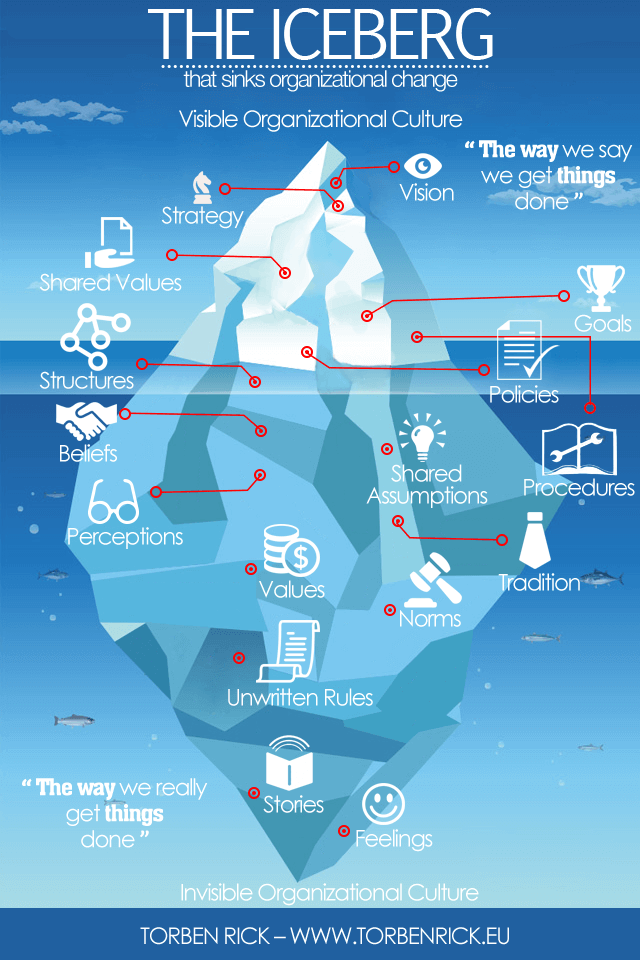What have the invisible man and the organizational culture in common
Do the invisible man and the organizational culture have anything in common?
Too many leaders assume they know what their organizational culture is. Often they think that it can be summed up in a slogan, like: “We have a culture of innovation” or “We’re an action based culture.” Others assume their values statement adequately represents their unique culture.
But in many cases they are ignoring or not paying attention to what’s below the organizations surface. They have a tendency to focus on “The way we say we get things done” and don’t focus on “The way we really get things done”.
Ignoring what’s below the surface will ultimately undermine organizational change.
Organizational culture is largely invisible, until it’s not

Organizational culture is largely invisible – Organizational culture is like an iceberg
The value of an organization will be measured by its capability to change
When creating a list of questions to asses the current culture, take into consideration aspects above AND below the surface: What specific cultural changes will visibly improve business results within 12 months?
The visible and invisible components that create organizational culture
- Is the organizational culture aligned with the strategy?
- Does the organizational culture encourage strategy execution?
- Does the organizational culture create competitive advantage for companies strategy?
- How effectively does the organizational culture currently drive internal and external performance metrics such as profit, sales/market growth, employee engagement, innovation etc.?
- Does the corporate culture bring out the best performance in the companies employees?
- What are the most common complaints employees make about the company culture?
- Does culture fosters trust?
- Does the culture that promotes quick responses to needed changes?
- Does decision-making authority exists at all levels, not just top management?
- What does the workplace “feel” like?
- Who is talking to whom (and who isn’t?)
- How do people interact?
- What stories do people tell about the organization or its “heroes?”
- How are customers, suppliers and other external stakeholders treated?
- Are there “rites of passage”? If so, what do they celebrate?
Any questions missing?
Short URL & Title:
Organizational culture is largely invisible — https://www.torbenrick.eu/t/r/jxr
Share it:
If you enjoyed this article, please take 5 seconds to share it on your social network. Thanks!








i would add 2 key points.
Culture is not universal across a business. Different teams have their own cultures. Some elements may be shared, but never all.
Culture can be sensed, but it must be looked for. You can not assume that it lines up with the posters.
Good article, and I particularly like the image. There is one major point I would like to state: Organisational culture is not defined by the marco level policies but the micro level employee behavioural characteristics of the employees: namely defined by their beliefs, values and ethics. Therefore, in agreement with the point made by Ted Roper, an organisation will comprise multiple micro cultures. Therefore a successful organisation is one that is able to effectively mesh these micro cultures to deliver the desired micro and macro productivity and profitability.
Thanks for sharing Torben, solid article with good questions.
Another question I think of is: How does the company and it’s co-workers address failure and anxiety and what is the response to threats.
As you know the answer is key to the ability of positive change way beyond the surface the very essence of our drivers, beliefs, convictions and you name it. Otherwise change will not go deeper then some superficial adaptations. Or we would only change the things that aren’t making the difference. And that would be a waste isn’t it.
Great article Torben.
I’d add that the hiring priorities of a company for senior and mid level management are really the keys to a company’s culture. Who you bring in and their attitude and approach will make the biggest difference – more than any other efforts to change culture in my experience. With fast growth startups (my area) its particularly important.
Torben, I like the graphic. I echo your comments that not all top organizational leaders want to see below the surface. Even when they don’t specifically know what lies below the surface, they are quite aware that there are multiple complexities lurking down there. Their initial preferred assumption is that all of the below surface activity is being conducted efficiently and effectively with positive impact on the organization. Therefore, the second preferred assumption is that the leadership’s vision of the organizational culture has transcended below the surface and become normalized. The result is the dichotomy between what the top organizational leadership wants its’ culture to be and what it actually is below the surface. My question is what does the top organizational leadership really want? A perception of their organizational culture that is basically superficial? Or, a perception of their culture that is also its’ reality?